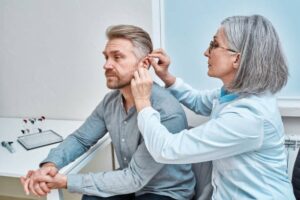A full diagnostic assessment is recommended if a screening test indicates hearing loss. This involves more comprehensive testing, including:
Pure tone audiometry – where your child must remain perfectly still (this can be turned into a game for younger children). For more information about the comprehensive hearing test Adelaide, click here.
This includes checking earwax and assessing the status of the middle ear (Tympanometry). A brainstem response test is also included.
Audiometry
 A hearing test is a standard procedure used by audiologists to measure your ability to hear different sounds. The results are presented on a graph known as an audiogram and are plotted against each ear. The horizontal axis shows your ability to detect sound pressure levels at different frequencies or pitches (tone), while the vertical axis represents the softest sounds you can hear.
A hearing test is a standard procedure used by audiologists to measure your ability to hear different sounds. The results are presented on a graph known as an audiogram and are plotted against each ear. The horizontal axis shows your ability to detect sound pressure levels at different frequencies or pitches (tone), while the vertical axis represents the softest sounds you can hear.
In a pure-tone audiometry exam, you sit in a quiet room with earphones connected to a machine that will play a series of tones at varying intensities and frequencies. The audiogram will show which tones you can’t hear and may indicate if your loss is conductive or sensorineural.
Tympanometry and acoustic reflex testing are also done in a quiet room to check the condition of your eardrum, ear canal and ossicle bones. These tests can reveal issues such as earwax build-up, tympanic membrane damage and middle ear problems, including tumours.
Otoscopy
The audiologist uses otoscopy to observe the health of your external auditory canal and tympanic membrane (ear drum). This can be used as an alternative to audiometry if there is a concern for middle ear fluid. For more information about the comprehensive hearing test Adelaide, click here.
The examiner gently pulls the pinna upward and backward with the hand not holding the otoscope to straighten the ear canal. This allows a clear visualization of the tympanic membrane. This helps the provider evaluate factors like its colour, the presence of a perforation and other canal structures.
The otoscope is then inserted into the ear canal. Using a sterile speculum and choosing the largest one that can fit comfortably in the patient’s external auditory canal is essential. The examiner should hold the otoscope with their free hand against their cheek to help stabilize it in case of sudden movement. It is also helpful to ask the patient which ears they prefer to look at first.
Tympanometry
A tiny muscle in the middle ear tightens when a loud sound is heard, called an acoustic reflex. How loud the sound has to be before the reflex occurs can tell us a lot about your hearing health, measured with a tympanometry test.
Tympanometry uses a broad-band click to induce pressure changes on the tympanic membrane, generating a sinusoidal signal for each probe frequency. These signals are then processed using Fourier analysis to obtain tympanometric measures at each of the frequencies tested.
The tympanograms are plotted as a graph of the relationship between ear-canal pressure and susceptance or conductance (see figure). A normal tympanogram looks like a mountain, peaking at about 0 data. Abnormal tympanograms may peak before or after this point, indicating a perforation in the eardrum, or a flat line indicates that the eardrum cannot move due to an outflow or other cause. Tympanometry is a handy screening tool for middle-ear disorders, although the availability of expensive testing equipment currently limits it. For more information about the comprehensive hearing test Adelaide, click here.
Auditory Brainstem Response (ABR)
The auditory brainstem response (ABR) is a non-invasive, painless test used to measure the neural responses of the inner ears and hearing pathways. The test is performed by placing electrodes on the head and recording the waveforms in response to acoustic signals. The test is typically performed while the patient is asleep or slightly sedated. It is a highly reliable testing method suitable for infants, children and patients who cannot respond to behavioural tests.
It is important to note that the ABR is very sensitive to changes in the brainstem auditory pathways’ conduction velocity and synaptic delays. For example, disorders that cause desynchronization of neural activity produce longer latency peaks or may even result in a complete absence of ABR peaks.